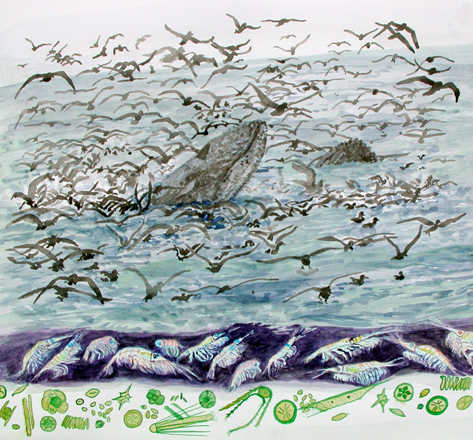.

Krill cycle, by artist and conservationist Carolyn Whan, represents the cycle of relationships between krill, phytoplankton, whales and moonbirds (shearwaters). Perhaps the movement qualities in her lines relate to her early training as a dancer.
Abstract to accompany the presentation of the animation, Energies.
No sense of an environment as a whole can be known through scientific data alone. Scientists study fragments of environments. Data are compiled using methods that require that observers maintain separation from their subjects. However, when data sets are presented in ways that connect to our experience of environments, we can connect to this information at a primal level. We naturally experience environments through kinaesthetic senses. These are all the senses that we use to inform us of our relationships to the physical and biological elements we encounter.
Animation can be used to combine scientific data with subjective responses to Antarctica. Data sets can be accurately traced and animated. Gestures and lines that convey sensory responses can be made and animated to combine with these.
Since ancient times, an elemental language of gestures and lines has been used to describe human relationships to environments. The circle, spiral, and cross have been identified as the basis of these languages. These elemental forms arise from gestures that are most naturally performed by virtue of the structure of the human body. These forms can be used to describe environments, and to convey a kinesthetic sense of being within them.
The Antarctic environment can be described by the circle, spiral and cross. The circumpolar current, the spiraling circulation of cold bottom water, and the cross that marks the spot where lines of longitude meet, provided a framework within which to combine scientific data sets and subjective responses to Antarctica.
Energies conveys a sense of being within some of the data sets that describe Antarctica’s changing environment.
Energies was inspired by seeing the birth of a krill, and hearing the insights of scientists who breed them. From this moment, krill became the focal point for combining animations that I had previously made to represent forces within the Antarctic ecosystem. Krill are central in the food web through which Antarctic life forms connect. The circular form of a krill egg resembles the structure of Antarctica and the world. The circle is symbolic of wholeness and connectivity.
In 2002, I experienced in Antarctica a heightened sense of being part of an environment that is notoriously difficult to describe. I also witnessed gestures of profound disappointment in the scientists working there, when we received news of the refusal of world leaders to ratify the Kyoto Protocol. These experiences compelled me to find ways to combine a sense of being in Antarctica with scientific evidence of its changing environment.
